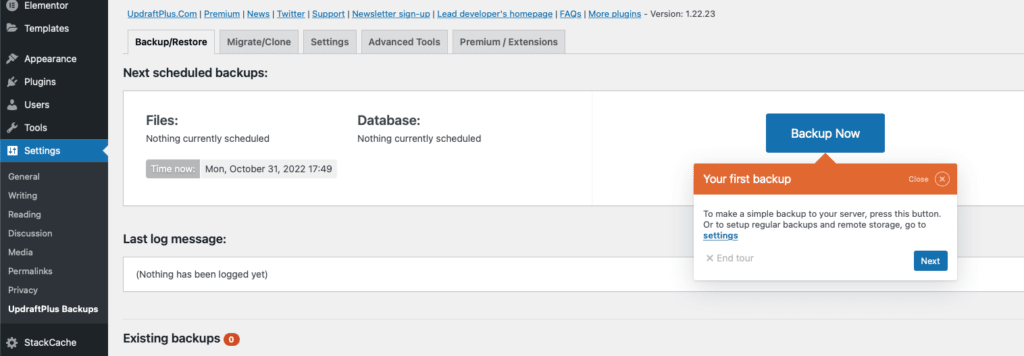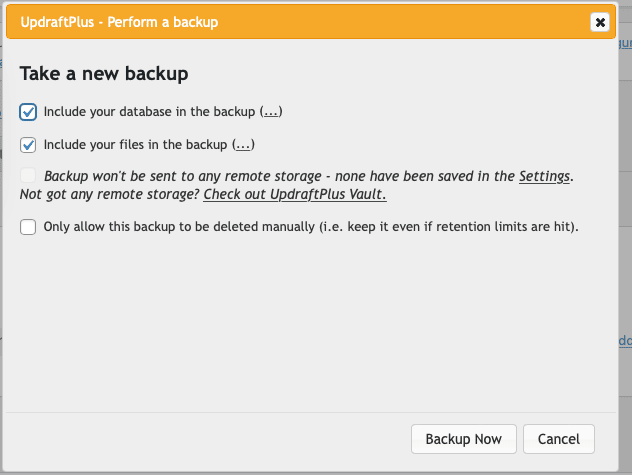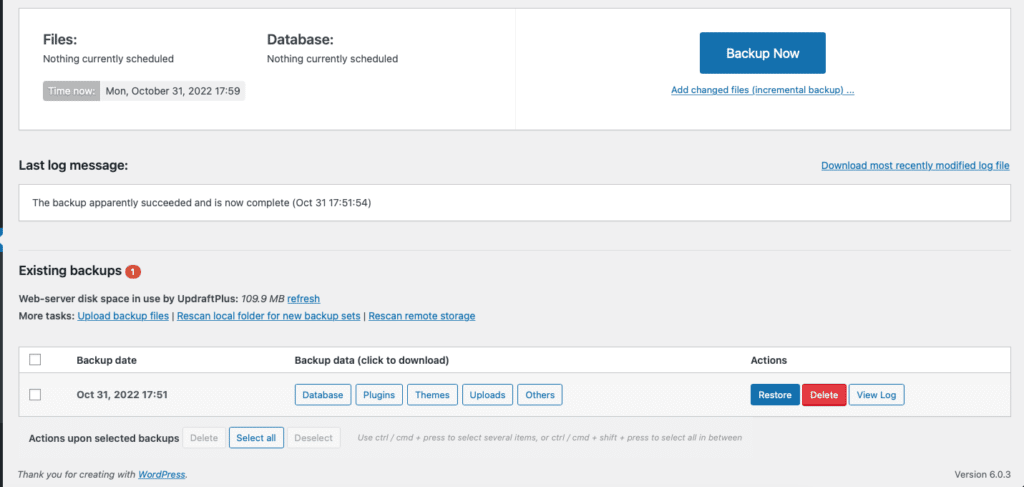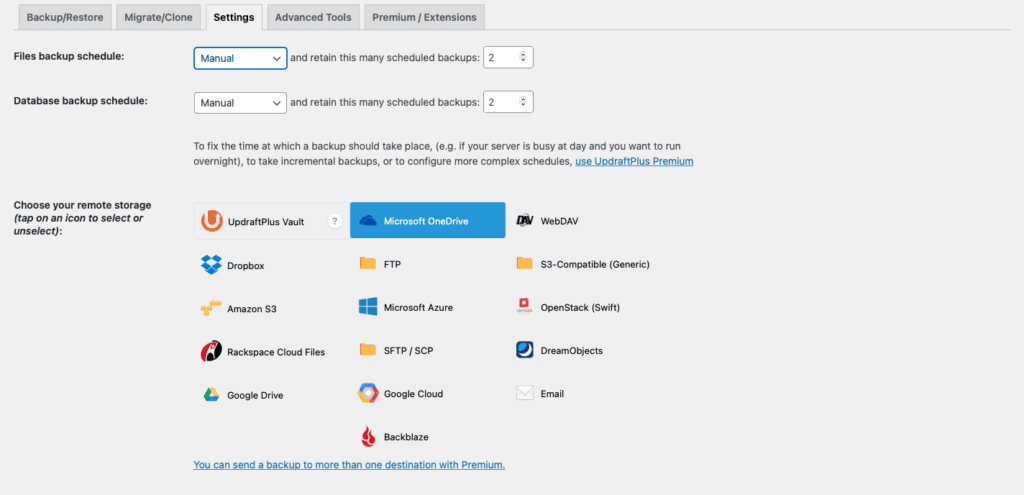As a small business, your website is an essential part of your business. It’s how you connect with customers, showcase your products or services, and generate leads and sales.
In other words, your website is your lifeline to the outside world. That’s why it’s so important to create regular backups of your site. Unfortunately, sometimes technology fails us, servers crash, a new plugin may break your site or you may fall foul to a hack where someone might gain control of your website.
With a website backup, you can rest assured knowing that your site can be up and running again in no time if something terrible ever happens to it.
What is a Website Backup?
A website backup is an exact copy of everything that makes up your website. It will include all your website files and databases.
A website backup is like an insurance policy for your site. Having a backup means that if something goes wrong, you won’t have to start from scratch, you can simply restore your site from the backup.
Backups are typically stored off-site, on a server or in the cloud, which provides an extra layer of protection in case something happens to your primary web hosting account. That way, you’ll always have a complete backup of site files and database backups that can be retrieved should anything go wrong.
Why Backups are Important
There are countless reasons why website backups are important, but I’ve listed the main ones below:-
- In the event of a hacking attack, you can quickly restore your entire site from a backup rather than starting from scratch or trying to piece together individual files that may be missing or damaged. we’ve written more about WordPress security in our dedicated post and a guide to malware that you can find here.
- Protect yourself from human error. Websites are complicated, and it’s quite easy to delete something from your site accidentally. If you do, having a point you can restore from rather than having to recreate it from scratch is handy (been there, done that!).
- If you make changes to your site, such as adding a new WordPress plugin that ends up breaking it, you can restore an older version of your site from a backup until you figure out what went wrong and how to fix it.
Having a backup plan
Imagine visiting your website shop and finding out the home page has got a dodgy ‘adult’ picture that you didn’t put there. It’s possible that you’d go into a blind panic and not know what to do first.
Having a backup plan that is written down somewhere that is easy to find and includes all details of an easy-to-follow backup process will help take some of the stress out of the process and get you back up and running as quickly as possible.
What to include in a backup process plan document.
Your plan will need to depend on how you want to take backups of your website. There are two ways to back up your website, either automated backups or manual backups. We’ll cover the differences in a bit more detail later.
The main things you should have in your plan are:-
- How are your backups taken
- Where they’re stored (and naming conventions if manual)
- How often do you take them i.e. Daily backups, weekly backups
- What type of backups are taken i.e. just website files or a full website backup that includes database backups
- Who’s responsible for the restoration and contact details?
- If you’re doing the restore yourself, you’ll want step-by-step instructions on how to restore backups with screenshots.
How to choose a backup service
As I’ve mentioned, there are two types of backup, those that are done automatically and those that are done manually. Write down your requirements before exploring your options and go with whatever fits best for your business, but we’d always recommend having daily backups of your site, maybe more if you’re a high-volume eCommerce business.
Automated backups
Web hosts usually offer this service sometimes as an added extra to hosting packages. We think these are the best type of backup as you’ve not got to remember to do one manually. If you go through your hosting provider, they’ll make sure that the backup is stored in a different place to your website and keep it safe. This will ensure that you’ll always have something to go back to.
If your website is WordPress based, there are also great plugins that you can use, such as UPDraftplus, that will allow you to take backups. Plugins are a great way of keeping control of your backups. The downside is that you might have to store them somewhere yourself manually.
Manual backup
Manual backups are the by far the cheapest option, as you’ll need to do the backup yourself. As you’re doing the backup yourself, you’ll need technical knowledge on how to save your website data and remember to create a website backup schedule so you don’t forget.
You’ll also need to find a safe place to store your website and need to know how to restore it if you need to. If you’re using WordPress, plugins can help again here, too, but they’re not always successful, which could cause other issues if something goes wrong.
Creating Backups: The How-To Guide
Creating backups of your website is much easier than you might think. If you’re using WordPress as your content management system (CMS), there are several plugins like UpDraftPlus that allow you to easily create both manual and automatic backups of your site with just a few clicks.
Simply install the plugin, set up automatic backups, and voila! Your WordPress site will now be backed up regularly without any further input from you.
If you’re not using WordPress or if you prefer not having yet another plugin installed on your site, most hosting providers offer some kind of backup solution as well; check with yours to see what they offer and how to set it up.
You can also always create manual backups by downloading all of the files associated with your website via FTP (File Transfer Protocol). These days, most hosts offer some sort of “staging” feature as well; staging allows you to create a duplicate version of your live site that can be used for testing purposes without affecting the actual live version of the site.
This comes in handy when making major changes or updates to avoid any potential disasters that could take down your entire website. Once you have backups created, be sure to store them safely off-site, preferably in the cloud (via Dropbox or Google Drive) or on an external hard drive so that they’re not affected if something happens to both your primary hosting environment AND your local computer/server.
If you’re using your host’s backup service, be sure to check where they host the secondary copy to make sure it’s offsite. You’ll also need to be sure to test them regularly (at least once per month) by restoring them on a local server or development environment; this will ensure that they work when you need them.
Plugin Backup – UpdraftPlus
Our hosting packages provide timeline backups free of charge, but if you want to use another solution, we’ll go over how to set up a plugin such as Updraft to do the work for you.
You’ll first need to download the plugin from your WordPress admin dashboard. If you’re not sure how to, check out our guide to the admin dashboard.
Once downloaded, you’ll need to activate the plugin, and the Updraft wizard will guide you through the process.

Once you’re ready to take your first website button, hit the backup now button.

You’ll then need to choose what to backup. We’d always recommend doing a full data backup rather than a partial backup that includes all website files and the database. You also have the option here to automatically send a copy of your backup to a remote storage provider such as dropbox once configured.

Once completed, you’ll see a copy of the backup appear at the bottom for safekeeping. You’ll be able to see what is in the backup, such as themes, database etc. and also some other actions like restore and delete.

If you click on the settings tab, you’ll be able to define some extra settings, such as your backup schedule, so you can have continuous backups for both website files and database as well as configure remote storage services such as dropbox or Onedrive to move your backup files to.

It’s important to remember that even though you might be taking backups automatically, you can still take a backup anytime.
How to Choose the Right Backup Solution
Websites take a lot of time to create and run. Sometimes, things can go drastically wrong for lots of different reasons.
Regularly backing your site will mean that should the unthinkable happen, you’ve always got a backup copy of your website that you can go back to.
There are lots of backup services and backup software that you can choose from, so do your research and find out what works best for you. Although I can’t stress enough that the best form of backup is one that you don’t have to think about and just happens. I’d also recommend doing a full backup and moving backup files to a remote location so you have a copy stored somewhere else other than your web server.
If you’re running your website day-to-day basis it’s always worth having a backup plan that you can share with your colleagues so that they know straight away who to contact if something goes wrong so you can get back up and running as quickly as possible.



